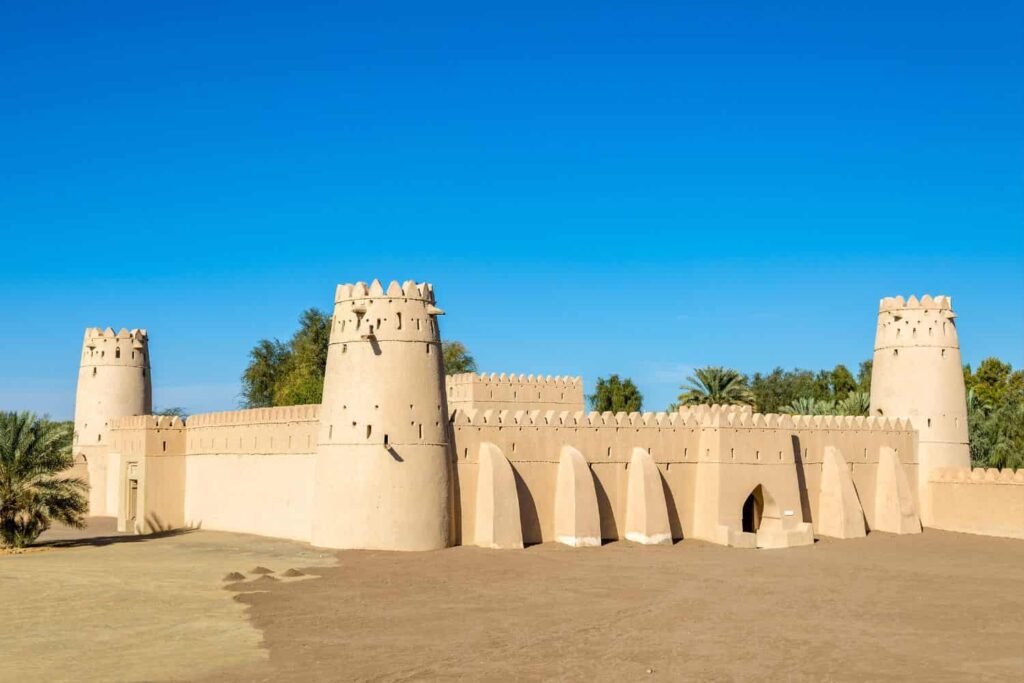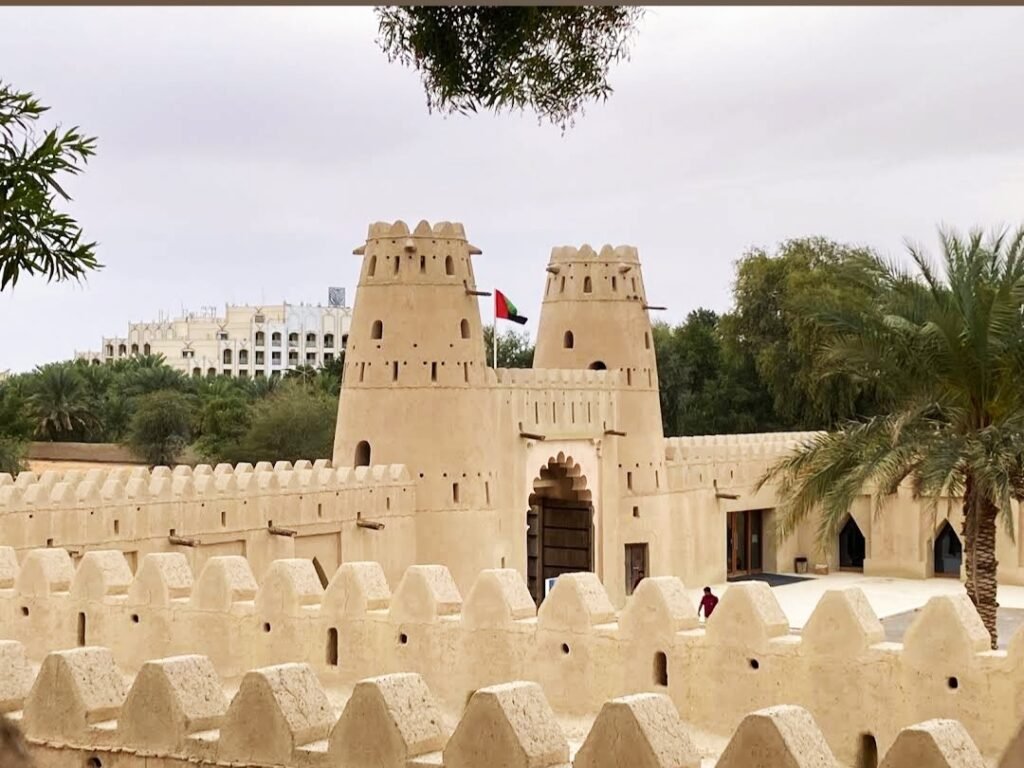When you think of Al Ain, the first thing that comes to mind might be the vast, open deserts, lush gardens, or perhaps the towering mountains surrounding the city. But nestled in the heart of this vibrant oasis city is a historical gem – Al Jahili Fort. This iconic landmark stands as a testament to the region’s rich cultural heritage and is one of the UAE’s most important historical structures.
Al Jahili Fort was originally built in the late 19th century, in 1891, under the guidance of the then Ruler of Al Ain, Sheikh Zayed the First. The fort’s construction was part of a larger effort to strengthen the defense of the region. At the time, it served as a strategic military stronghold and a place for the local government to maintain order. Today, however, it is a peaceful monument to the past, offering visitors a glimpse into the rich history and traditions of the UAE.
The Fort’s Unique Architecture
One of the first things visitors notice when approaching Al Jahili Fort is its imposing yet elegant architecture. Made from traditional mud brick and palm fronds, the fort is a beautiful example of the region’s indigenous building techniques. The fort’s large watchtowers, high walls, and spacious courtyards tell the story of a time when protecting the community was of utmost importance.

The fort is shaped like a square, with round towers at each corner, offering panoramic views of the surrounding area. These towers were built to help guards keep watch for potential threats in the distance, particularly during times when tribal conflicts were more common. The outer walls were designed to be strong enough to withstand attacks, yet the interior of the fort exudes a sense of serenity and peace. Walking through its spacious courtyards and into the rooms within, one can imagine the life that once filled these walls.
Historical Significance of Al Jahili Fort
Al Jahili Fort isn’t just an architectural marvel; it also holds great historical significance. It was not only a military stronghold but also the residence of prominent figures. The fort is closely linked with the Al Nahyan family, the ruling family of the UAE. In fact, it is said that the fort once served as the home for Sheikh Zayed the First and his family.

In addition to its military role, Al Jahili Fort also served as a place for the tribe’s leaders to gather and discuss important matters. It was a hub for political activity and a symbol of authority in the region. The fort’s location, in the middle of Al Ain’s oasis, was ideal for overseeing the surrounding agricultural lands and ensuring that the community’s needs were met.
Renovation and Preservation Efforts
Al Jahili Fort underwent significant renovations in the early 2000s to restore its former glory. In 2008, the fort was reopened to the public after extensive restoration work by the Abu Dhabi Authority for Culture and Heritage. These efforts included the restoration of the fort’s distinctive watchtowers, walls, and other features.
The goal of the restoration was not only to preserve the fort’s historical integrity but also to make it a space where visitors could experience the UAE’s history firsthand. Today, the fort offers visitors a chance to learn about the past through interactive exhibits and displays that provide a deeper understanding of the region’s cultural evolution. The Al Jahili Fort is also home to a number of important artifacts, including photographs, historical documents, and tools that were once used by the fort’s residents.
Al Jahili Fort Today
Now, Al Jahili Fort has become a must-see destination for both history enthusiasts and tourists alike. It is part of a larger effort to preserve the UAE’s cultural heritage and ensure that future generations understand the country’s roots. Whether you are a local resident or a visitor to the UAE, a trip to Al Jahili Fort offers a chance to step back in time and experience the traditional way of life in the Emirates.
Visitors to the fort can explore the museum housed within the fort, which showcases a variety of exhibits detailing the history of the region, the fort’s role in protecting Al Ain, and the life of the ruling family. One of the key highlights of the museum is the exhibition dedicated to the famous British explorer, Wilfred Thesiger, who passed through the region in the 1940s. Thesiger’s photographs and writings are displayed to show his deep connection with the people and culture of the UAE.

Al Jahili Fort is also a popular location for cultural events. Throughout the year, visitors can enjoy traditional Emirati music, dance performances, and other cultural activities that bring the fort’s rich history to life. During the cooler months, the fort’s spacious grounds are used for outdoor events, such as falconry displays and art exhibitions, which attract visitors from around the world.
Exploring the Surroundings
While the fort itself is undoubtedly the main attraction, there is plenty to explore in the surrounding area as well. Al Ain is known for its green parks, tranquil gardens, and lush oases. The Al Ain Oasis, just a short walk from the fort, is another UNESCO World Heritage site and provides a stunning contrast to the arid desert landscapes that surround the city. The oasis features a network of ancient irrigation systems called “falaj,” which have been used for centuries to bring water to the agricultural lands.
In addition, visitors can explore the nearby Al Ain National Museum, which houses a rich collection of artifacts and exhibits related to the city’s history and culture. The museum is a great place to gain a deeper understanding of Al Ain’s past and its role in the development of the UAE.
A Cultural Experience for All Ages
Al Jahili Fort offers something for everyone. Whether you’re interested in history, architecture, or culture, the fort is an enriching experience. It’s a place where visitors can immerse themselves in the traditions of the UAE and learn about the role this beautiful country played in the larger story of the Arabian Peninsula.
The fort is family-friendly, making it a perfect destination for those with children. The spacious courtyards are ideal for a leisurely stroll, and the exhibits provide an engaging and educational experience for younger visitors. For those seeking a deeper understanding of the UAE’s history, the fort’s knowledgeable staff are always on hand to offer insights and answer questions.
Conclusion
Al Jahili Fort is much more than just a historic landmark – it is a symbol of the resilience and culture of the UAE. With its impressive architecture, rich history, and captivating exhibits, it provides a fascinating glimpse into the past while serving as a reminder of the importance of preserving cultural heritage. A visit to Al Jahili Fort is a must for anyone looking to explore the heart of Al Ain and discover the stories that shaped the Emirates into what they are today.
Also read: Gulf Pearl Tower: Sharjah’s Hidden Gem with Breathtaking Views













